Gantry Crane Mongolia, All Types of Gantry Cranes 1 T to 550 Ton
Gantry Cranes for Sale and Operation in Mongolia
Gantry cranes play a crucial role in the industrial landscape of Mongolia, providing essential lifting and material handling solutions across various sectors. Whether it's in mining, construction, manufacturing, or logistics, gantry cranes are indispensable tools for moving heavy loads with precision and efficiency. In this comprehensive guide, we'll explore the significance of gantry cranes in Mongolia's industrial sectors and provide valuable insights into their selection, operation, and maintenance.
Throughout this guide, we aim to provide practical information that will help businesses in Mongolia make informed decisions when it comes to gantry crane investment and utilization. From understanding the basics of gantry crane operation to navigating the purchasing process and ensuring compliance with safety regulations, we've got you covered.
Let's dive in and explore how gantry cranes contribute to the success and productivity of Mongolia's industrial operations.
Gantry Cranes for Sale Mongolia
Gantry cranes are essential pieces of equipment used for lifting and moving heavy loads in industrial settings. They are characterized by their tall, gantryshaped framework, which supports a horizontal beam (or beams) that traverses the length of the structure. Here's a breakdown of the key aspects of gantry cranes:
Definition and Basic Components:
Gantry cranes are overhead cranes with a horizontal beam supported by two or more legs that run along rails mounted on the ground. The main components of a gantry crane include:
Bridge: The horizontal beam that spans the width of the gantry crane and supports the hoist and trolley.
Legs: Vertical supports that provide stability and support the bridge structure.
End trucks: Mounted on the bridge, these carry the hoist and trolley and allow them to move along the length of the bridge.
Hoist: The lifting mechanism that raises and lowers the load.
Trolley: Moves horizontally along the bridge, allowing the hoist to position the load accurately.
Different Types of Gantry Cranes:
Gantry cranes play a vital role in various industries, including construction, shipping, and logistics. While I don't have specific information on gantry cranes used exclusively in Mongolia, I can provide an overview of common types of gantry cranes that might be used there: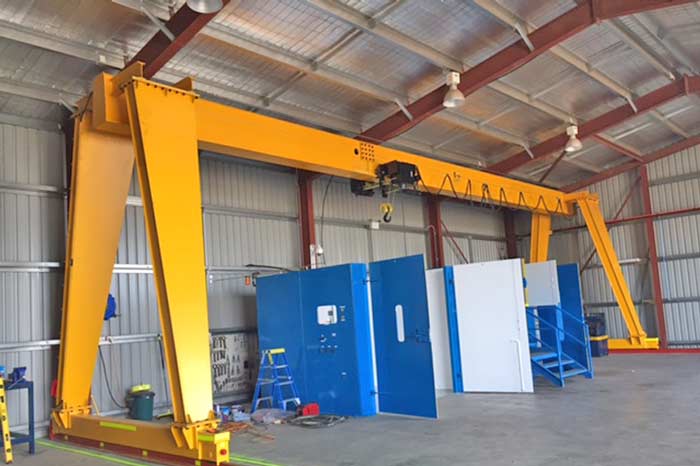
Single Girder Gantry Crane:
Single girder gantry cranes have one bridge girder that spans the width of the gantry structure.
They are typically used for light to moderate lifting applications and are suitable for smaller workspaces.
Single girder gantry cranes are often more costeffective and easier to install compared to double girder gantry cranes.
They are commonly used in workshops, warehouses, manufacturing facilities, and outdoor construction sites.
These cranes are versatile and can be equipped with various lifting mechanisms such as electric chain hoists or wire rope hoists.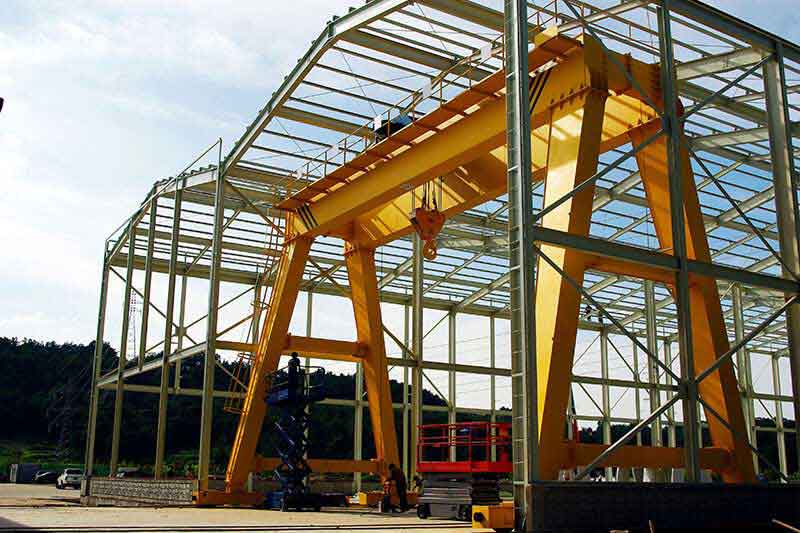
Double Girder Gantry Crane:
Double girder gantry cranes feature two bridge girders that run parallel to each other, providing increased stability and lifting capacity.
They are suitable for heavyduty lifting applications and can handle larger loads with higher precision.
Double girder gantry cranes offer greater hook height and lift capacities compared to single girder cranes, making them ideal for largescale industrial operations.
They are commonly used in industries such as steel fabrication, shipbuilding, aerospace, and heavy machinery manufacturing.
Double girder gantry cranes can be equipped with specialized lifting attachments, such as magnet beams or grabs, for handling specific types of cargo.
These cranes are robust and durable, capable of operating in demanding environments with high temperatures, dust, or corrosive materials.
Both single girder and double girder gantry cranes have their advantages and are chosen based on factors such as lifting capacity, span, height, operational requirements, and budget constraints. In Mongolia, depending on the industries and specific lifting needs, either type of gantry crane or a combination of both may be utilized across different sectors such as mining, construction, and logistics.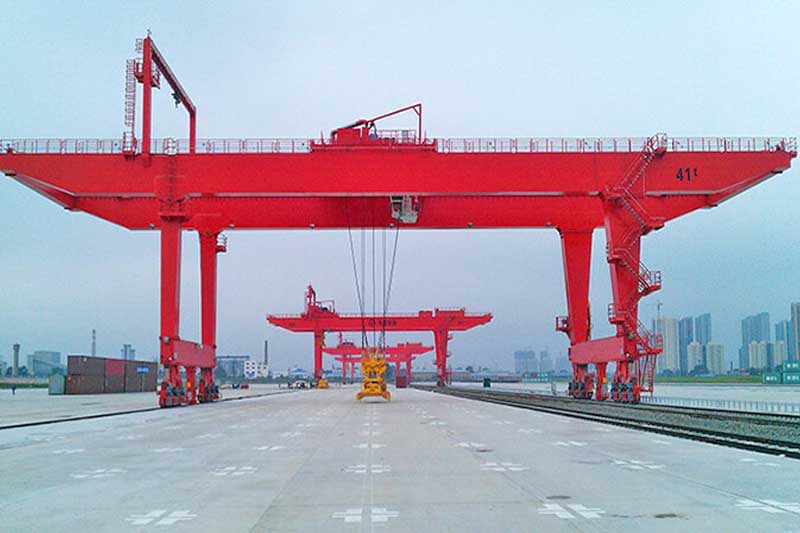
Rail Mounted Gantry Crane (RMG):
RMGs are commonly used in ports and container yards. They run on rails, allowing them to move parallel to the dock or storage area.
They are typically used for stacking and moving containers in maritime shipping terminals.
RMGs are known for their efficiency and ability to handle heavy loads.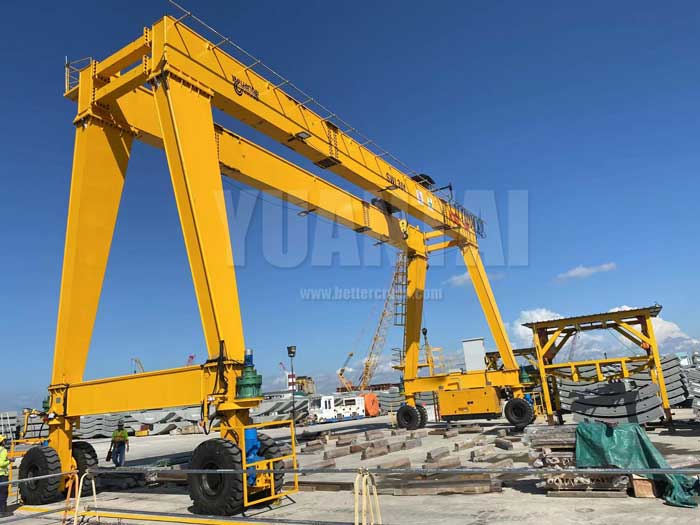
Rubber Tired Gantry Crane (RTG):
RTGs are similar to RMGs but use rubber tires instead of rails for mobility.
They are versatile and can operate in various environments, including ports, rail yards, and storage yards.
RTGs are popular due to their flexibility and mobility, allowing them to navigate different surfaces.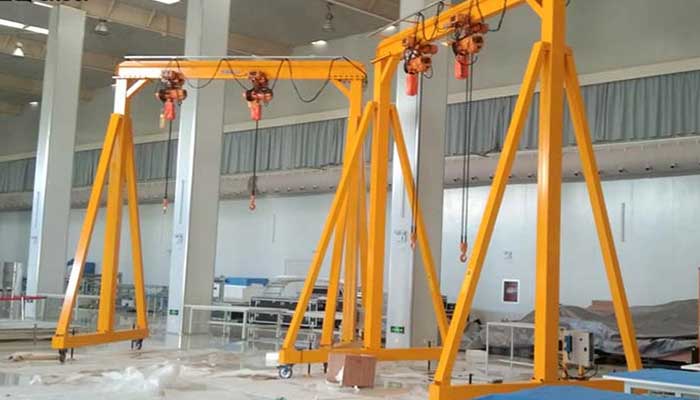
Mobile Gantry Crane:
These gantry cranes are mounted on wheels or tracks, allowing them to be moved easily within a worksite.
They are often used in construction projects, warehouses, and manufacturing facilities.
Mobile gantry cranes offer flexibility and are ideal for temporary lifting needs or where infrastructure for fixed gantry cranes is not available.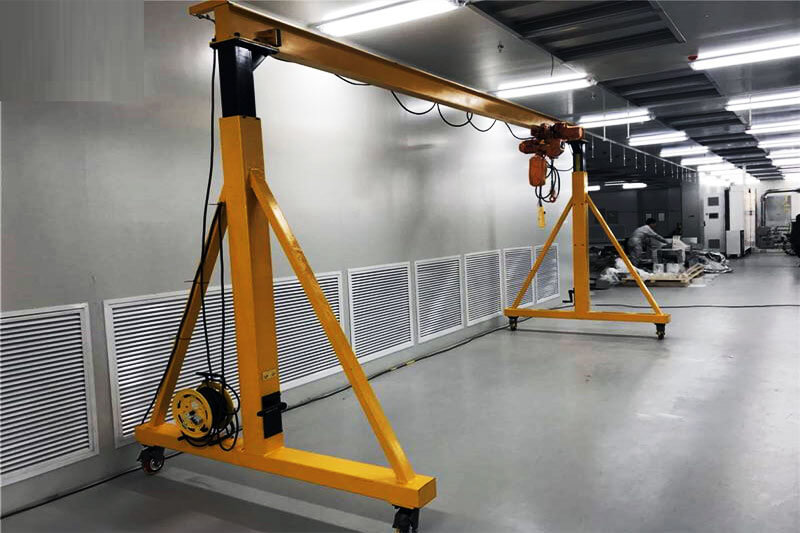
Adjustable Height Gantry Crane:
These gantry cranes feature adjustable height settings, allowing them to accommodate various lifting requirements.
They are commonly used in workshops, maintenance facilities, and smallscale manufacturing operations.
Adjustable height gantry cranes offer versatility and can be customized to suit specific lifting tasks.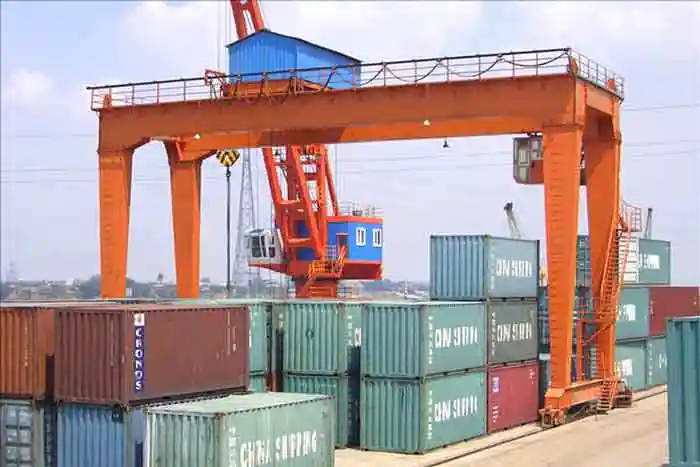
Container Gantry Crane:
Specifically designed for handling shipping containers, these gantry cranes are common in ports and container terminals.
They feature specialized spreader bars or attachments for lifting and stacking containers.
Container gantry cranes are essential for efficient cargo handling and are often automated for increased productivity.
These are just a few examples of gantry crane types commonly used worldwide. Depending on the specific needs and infrastructure in Mongolia, a combination of these types or specialized variations may be employed in various industries across the country.
Gantry Crane Operation:
- Lifting Mechanism: Gantry cranes use a hoist and trolley system to lift and lower loads vertically. The hoist is attached to a hook or other lifting attachment, while the trolley moves horizontally along the bridge girder to position the load.
- Bridge Movement: Gantry cranes move along a runway or track system, allowing them to traverse the length of the workspace. The bridge movement is powered by electric motors, providing smooth and precise control.
- Trolley Movement: The trolley moves along the bridge girder, allowing for lateral movement of the load. This movement is also powered by electric motors, enabling precise positioning of the load.
- Control System: Gantry cranes are typically operated using a control pendant or a remote control system. Operators can use these controls to maneuver the crane and perform lifting, lowering, and movement functions.
Typical Features of Gantry Cranes:
Smooth Movement:
Gantry cranes are powered by electric motors, ensuring smooth and precise movement for efficient material handling. This smooth operation enhances productivity and minimizes the risk of load damage.
Safety Features:
Gantry cranes are equipped with various safety devices to prevent accidents and ensure operator safety. These may include:
Limit switches to prevent overtravel of the crane or trolley.
Overload protection systems to prevent lifting beyond the crane's rated capacity.
Emergency stop buttons to immediately halt crane operation in case of emergencies.
Customizable Configurations
Gantry cranes can be customized to meet specific application requirements. Some common customizations include:
Telescopic booms or extendable arms to reach difficulttoaccess areas.
Specialized lifting attachments such as magnets, grabs, or spreader bars for handling different types of loads.
Adjustable height settings to accommodate varying load sizes or workspace constraints.
Industrial Sectors and Applications
Mongolia's economy relies on a diverse range of industrial sectors, each with its unique requirements for material handling and lifting solutions. Gantry cranes play a vital role in facilitating efficient operations across these sectors. Here's a closer look at how gantry cranes are utilized in key industries in Mongolia:
Mining:
Gantry cranes are essential for the mining industry in Mongolia, where they are used for lifting and transporting heavy equipment, machinery, and raw materials at various stages of the mining process.
Typical applications include loading and unloading ore from trucks and railcars, moving materials within mining facilities, and assembling or disassembling mining equipment.
Gantry cranes with high lifting capacities are often required to handle the massive loads encountered in the mining sector, such as ore, rocks, and machinery components.
Construction:
In the construction industry, gantry cranes are employed for lifting and positioning building materials, structural components, and equipment at construction sites across Mongolia.
They are used for tasks such as erecting steel beams, hoisting precast concrete elements, and assembling modular structures.
Gantry cranes provide the flexibility and reach needed to navigate the dynamic and often challenging environments encountered in construction projects, including urban areas and remote sites.
Manufacturing:
Gantry cranes are integral to manufacturing operations in Mongolia, where they facilitate the movement of heavy machinery, parts, and finished products within manufacturing facilities.
They are utilized in various manufacturing processes, including metal fabrication, automotive production, and industrial assembly lines.
Gantry cranes play a critical role in optimizing production workflows, reducing downtime, and ensuring efficient material flow in manufacturing operations.
Agriculture:
In the agricultural sector, gantry cranes are used for handling bulk materials such as grain, feed, and fertilizer in storage and processing facilities.
They are also employed for lifting and positioning agricultural machinery and equipment, including tractors, combines, and irrigation systems.
Gantry cranes assist in loading and unloading agricultural products from trucks and storage bins, streamlining operations and minimizing manual labor.
Logistics:
Gantry cranes are essential for logistics and warehousing operations in Mongolia, where they facilitate the movement of goods and materials in distribution centers, ports, and freight terminals.
They are used for loading and unloading shipping containers, stacking and retrieving palletized goods, and organizing inventory in storage facilities.
Gantry cranes with high lifting heights and capacities are employed in logistics applications to handle large and heavy loads efficiently.
In summary, gantry cranes find widespread use across various industrial sectors in Mongolia, where they contribute to productivity, efficiency, and safety in material handling operations. Whether it's in mining, construction, manufacturing, agriculture, or logistics, gantry cranes play a crucial role in supporting the diverse economic activities of the country.
Selecting the Right Gantry Crane
Choosing the right gantry crane is essential to ensure efficient and safe material handling operations in industrial settings. Here's a detailed look at the factors to consider and guidance for selecting the appropriate gantry crane for specific needs:
Load Capacity:
One of the most critical factors to consider is the maximum weight of the load that the gantry crane will need to lift and move.
Evaluate the heaviest loads expected to be handled regularly to determine the required load capacity of the crane.
Ensure the selected gantry crane has a sufficient lifting capacity with a safety margin to accommodate potential load variations.
Span and Lifting Height:
Consider the span of the gantry crane, which is the distance between the legs or support structure.
Determine the required lifting height, taking into account the clearance required for lifting loads to the desired height.
Choose a gantry crane with an appropriate span and lifting height to ensure it can cover the required work area and reach the desired lifting locations.
Environment:
Assess the operating environment where the gantry crane will be used, considering factors such as temperature, humidity, dust, and corrosive elements.
Select a gantry crane with suitable environmental protection features, such as corrosionresistant coatings, weatherproof components, and sealed electrical enclosures.
Ensure the gantry crane is designed to withstand the specific environmental conditions present in the industrial facility or outdoor work area.
Specific Application Requirements:
Evaluate the specific requirements of the industrial application where the gantry crane will be used.
Consider factors such as the frequency of use, the type of materials being handled, and the precision and speed required for lifting and positioning.
Determine any specialized features or accessories needed, such as lifting attachments, remote controls, or safety devices, to meet the demands of the application.
Type and Configuration of Gantry Crane:
Choose the appropriate type and configuration of gantry crane based on the application requirements and operating conditions.
Single girder gantry cranes are suitable for light to mediumduty lifting tasks, while double girder gantry cranes offer higher lifting capacities and stability for heavyduty applications.
Semigantry cranes provide flexibility in confined spaces where one side of the crane is supported by legs, and the other side runs on rails attached to an existing structure.
By carefully considering these factors and assessing the specific requirements of the industrial application, businesses in Mongolia can select the right gantry crane to optimize their material handling operations and ensure productivity, efficiency, and safety in the workplace.
Purchasing Gantry Cranes
Investing in a gantry crane is a significant decision for any industrial operation in Mongolia. To ensure a smooth purchasing process and obtain a crane that meets your specific needs, it's essential to understand the steps involved and consider several factors. Here's a comprehensive guide to purchasing gantry cranes in Mongolia:
Overview of the Purchasing Process:
Start by assessing your lifting requirements and determining the specifications and features needed for your gantry crane.
Research reputable gantry crane suppliers and manufacturers in Mongolia, either through online searches or referrals from industry peers.
Contact potential suppliers to discuss your requirements and request quotations for the desired crane models.
Considerations for New vs. Used Cranes:
Decide whether to purchase a new or used gantry crane based on your budget, timeline, and performance requirements.
New cranes offer the latest technology, warranty coverage, and customization options, but they come at a higher initial cost.
Used cranes may provide cost savings upfront but require thorough inspection to ensure they meet safety and performance standards.
Tips for Evaluating Suppliers and Manufacturers:
Reputation and Experience: Choose a gantry crane supplier with a proven track record and extensive experience in the industry.
Product Quality: Assess the quality of the gantry cranes offered by the supplier, including materials, construction, and reliability.
Customization Options: Look for suppliers who can tailor the gantry crane to your specific requirements, such as load capacity, span, and lifting height.
Service and Support: Inquire about aftersales services, maintenance support, and spare parts availability provided by the supplier.
Pricing and Value: Compare quotations from multiple suppliers to ensure you're getting competitive pricing without compromising on quality or service.
Documentation and Contracts:
Review the terms and conditions outlined in the purchase agreement or contract provided by the supplier.
Ensure all specifications, warranties, delivery timelines, and payment terms are clearly defined and agreed upon before finalizing the purchase.
Seek legal advice if necessary to ensure the contract protects your interests and complies with local regulations.
Installation and Training:
Coordinate with the supplier to schedule the installation of the gantry crane and any necessary training for operators and maintenance personnel.
Ensure the installation is carried out by qualified technicians and complies with safety regulations and standards.
Purchasing a gantry crane is a significant investment that requires careful consideration of various factors. By following these steps and tips, businesses in Mongolia can make informed decisions and acquire gantry cranes that meet their lifting requirements while ensuring safety, reliability, and value for money.
Installation and Commissioning of Gantry Cranes
Proper installation and commissioning of gantry cranes are critical to ensuring their safe and efficient operation in industrial environments. Here's a detailed look at the steps involved, the importance of safety regulations, and crane testing and certification procedures:
Site Preparation:
Begin by preparing the installation site for the gantry crane, ensuring a level and stable foundation to support the crane's weight and load.
Clear any obstacles or debris from the area to provide sufficient space for crane assembly and operation.
Ensure adequate access for crane components, equipment, and personnel during the installation process.
Assembly and Erection:
Follow the manufacturer's instructions and engineering drawings to assemble the gantry crane components accurately.
Use proper lifting equipment and techniques to position and secure the crane structure, including the legs, bridge, end trucks, and hoisting mechanism.
Verify that all connections are tight and secure before proceeding with the installation.
Electrical and Mechanical Installation:
Install electrical wiring, control panels, and power supply systems according to the crane's specifications and safety standards.
Connect the crane's electrical components, including motors, brakes, limit switches, and safety devices, ensuring proper wiring and insulation.
Perform mechanical adjustments and alignments to ensure smooth and reliable crane operation.
Safety Regulations and Standards:
Adhere to applicable safety regulations and standards during the installation process, including local, national, and international standards such as ISO, OSHA, and ASME.
Implement proper safety measures, including personal protective equipment (PPE), fall protection systems, and barricades, to prevent accidents and injuries during installation.
Testing and Commissioning:
Conduct thorough testing of all crane functions, including hoisting, lowering, trolley travel, and bridge movement, to ensure proper operation and performance.
Perform load tests to verify the crane's lifting capacity and stability under working conditions.
Record and document test results, including any adjustments or corrections made during the testing process.
Certification and Compliance:
Obtain certification from relevant regulatory authorities or thirdparty inspection agencies to confirm compliance with safety and performance standards.
Ensure all installation and testing procedures are documented and maintained for future reference and regulatory compliance.
Conduct regular inspections and maintenance checks to keep the gantry crane in optimal working condition and extend its service life.
Proper installation and commissioning of gantry cranes are essential for ensuring their safe and reliable operation in industrial environments. By following the steps outlined above and adhering to safety regulations and standards, businesses in Mongolia can maximize the efficiency and productivity of their material handling operations while maintaining a safe working environment for personnel.
Operation and Maintenance of Gantry Cranes
Proper operation and maintenance practices are essential for ensuring the safe and efficient performance of gantry cranes in industrial settings. Here's a detailed overview of training requirements for operators, best practices for safe crane operation, and guidelines for regular maintenance and inspection:
Training Requirements for Gantry Crane Operators:
Gantry crane operators in Mongolia should undergo comprehensive training to develop the knowledge, skills, and competencies required for safe and efficient crane operation.
Training programs should cover topics such as crane controls, load handling techniques, safety procedures, and emergency protocols.
Operators should receive handson training under the supervision of experienced instructors and undergo periodic refresher courses to maintain proficiency.
Best Practices for Safe Crane Operation:
Follow established safety protocols and procedures when operating gantry cranes, including preoperational checks, load assessments, and communication with other personnel.
Ensure proper rigging and attachment of loads to the crane hook, using appropriate lifting accessories and techniques.
Avoid exceeding the crane's rated capacity or operating outside its designated load limits to prevent accidents and equipment damage.
Maintain clear communication between crane operators and ground personnel using hand signals, radios, or other communication devices.
Observe environmental conditions such as wind, weather, and visibility, and take appropriate precautions to mitigate risks during crane operation.
Guidelines for Regular Crane Maintenance and Inspection:
Implement a proactive maintenance program for gantry cranes, including routine inspections, lubrication, and component replacements as needed.
Conduct daily preoperational checks to inspect critical components such as brakes, hoists, ropes, and electrical systems for signs of wear, damage, or malfunction.
Perform scheduled maintenance tasks according to the manufacturer's recommendations and industry best practices, including lubrication of moving parts and adjustment of tensioning systems.
Keep detailed records of maintenance activities, including inspection reports, repair records, and service intervals, to track the crane's performance and compliance with regulatory requirements.
By adhering to these training, operational, and maintenance practices, businesses in Mongolia can ensure the safe and reliable operation of gantry cranes in their industrial operations. Investing in operator training, implementing best practices for safe operation, and maintaining regular maintenance and inspection schedules are essential steps in maximizing the efficiency, productivity, and longevity of gantry crane systems.
Troubleshooting and Repairs of Gantry Cranes
Even with regular maintenance and careful operation, gantry cranes may encounter issues or malfunctions that require troubleshooting and repairs. Here's an indepth look at common problems, troubleshooting tips, and available repair and maintenance services in Mongolia:
Common Issues and Problems:
Electrical Malfunctions: Problems with electrical components such as motors, brakes, contactors, and wiring can lead to crane downtime and reduced performance.
Mechanical Failures: Issues with mechanical components like bearings, gears, wheels, and structural elements may cause abnormal noises, vibrations, or movement.
Control System Errors: Faulty control systems, including pendant controls, radio remotes, and PLCs, can result in erratic crane behavior or loss of functionality.
Wear and Tear: Normal wear and tear over time can lead to degradation of crane components, affecting performance, efficiency, and safety.
Troubleshooting Tips:
Conduct a thorough visual inspection of the crane to identify any visible signs of damage, wear, or misalignment.
Check electrical connections, fuses, and circuit breakers for signs of overheating, corrosion, or loose connections.
Inspect mechanical components for wear, damage, or misalignment, paying particular attention to bearings, gears, wheels, and structural welds.
Use diagnostic tools such as multimeters, infrared thermometers, and vibration analyzers to identify specific issues with electrical and mechanical systems.
Refer to the crane's operation manual or consult with technical support from the manufacturer for troubleshooting guidance and recommended solutions.
Repair and Maintenance Services:
In Mongolia, businesses can access a range of repair and maintenance services for gantry cranes from qualified technicians and service providers.
Authorized service centers and dealerships offer specialized repair and maintenance services for various crane makes and models, ensuring quality workmanship and genuine replacement parts.
Independent crane service companies provide onsite repair and maintenance services, including inspections, repairs, upgrades, and emergency breakdown support.
Some crane manufacturers may offer comprehensive service contracts or maintenance agreements, providing regular inspections, preventive maintenance, and priority support for repairs and replacements.
Preventive Maintenance Strategies:
Implement a proactive maintenance strategy to prevent issues before they occur, including regular inspections, lubrication, and component replacements.
Keep detailed records of maintenance activities, including inspection reports, repair history, and service schedules, to track the crane's performance and identify trends or recurring issues.
Train maintenance personnel on proper maintenance procedures and troubleshooting techniques to ensure effective maintenance practices and timely repairs.
By following these troubleshooting tips and utilizing repair and maintenance services available in Mongolia, businesses can address gantry crane issues promptly, minimize downtime, and ensure the continued safe and reliable operation of their crane systems.
Compliance and Safety in Gantry Crane Operations
Ensuring compliance with regulatory requirements and maintaining a safe working environment are paramount for gantry crane operations in Mongolia. Here's a comprehensive overview of regulatory standards, safety compliance, and tips for promoting safety in the workplace:
Regulatory Requirements and Standards:
Gantry crane operations in Mongolia are subject to various regulatory requirements and standards set forth by government agencies and industry organizations.
Regulatory bodies such as the Ministry of Labor and Social Protection and the General Authority for State Inspection enforce workplace safety regulations and standards applicable to gantry crane operations.
International standards such as ISO 12482 and national standards like Mongolian Industrial Safety Standards (MISS) provide guidelines for the design, operation, and maintenance of gantry cranes to ensure safety and compliance.
Importance of Safety Compliance:
Compliance with safety regulations is essential to prevent accidents, injuries, and fatalities associated with gantry crane operations.
Adhering to safety standards helps minimize risks, protect workers' health and wellbeing, and avoid costly penalties or legal liabilities resulting from noncompliance.
Safety compliance also enhances productivity and efficiency by reducing downtime due to accidents or equipment failures and fostering a culture of safety awareness in the workplace.
Tips for Creating a Safe Working Environment:
Conduct regular safety inspections and risk assessments to identify potential hazards and implement appropriate control measures.
Provide comprehensive training and certification programs for gantry crane operators, maintenance personnel, and other workers involved in crane operations.
Ensure proper maintenance and inspection of gantry cranes in accordance with manufacturer recommendations and regulatory requirements.
Establish clear procedures and protocols for crane operations, including load handling, signaling, and emergency response.
Implement safety measures such as guarding, barricades, and warning signs to prevent unauthorized access to crane areas and protect workers from falling objects or moving machinery.
Encourage open communication and reporting of safety concerns among workers, supervisors, and management to address issues promptly and effectively.
By prioritizing compliance with regulatory standards and promoting a safetyconscious work environment, businesses in Mongolia can mitigate risks associated with gantry crane operations and ensure the wellbeing of their workers while maintaining productivity and efficiency in industrial settings.
Conclusion: Cost-effective Gantry Crane for Sale Mongolia, Get Your Custom Design
As we conclude this comprehensive guide to gantry crane operations in Mongolia, let's recap the key takeaways and reflect on the significance of gantry cranes in the country's industrial landscape.
Summary of Key Takeaways:
Gantry cranes play a crucial role in various industrial sectors in Mongolia, including mining, construction, manufacturing, agriculture, and logistics.
Understanding the different types of gantry cranes, their operation, and their applications is essential for businesses seeking to improve their material handling capabilities.
Selecting the right gantry crane involves considering factors such as load capacity, span, lifting height, and environmental conditions to meet specific operational requirements.
Purchasing, installing, and commissioning gantry cranes requires careful planning, adherence to safety regulations, and collaboration with reputable suppliers and service providers.
Proper operation, maintenance, and regular inspections are essential for ensuring the safe and efficient performance of gantry cranes over their service life.
Compliance with regulatory requirements and safety standards is critical to preventing accidents, injuries, and disruptions to industrial operations.
Gantry cranes are indispensable tools for enhancing productivity, efficiency, and safety in Mongolia's industrial sector. Whether lifting heavy loads in mining operations, facilitating construction projects, or handling materials in manufacturing facilities, gantry cranes provide the lifting power and versatility needed to meet the demands of modern industrial operations.
Investing in gantry crane solutions is not just about acquiring equipment—it's about investing in the success and growth of your business. By choosing the right gantry crane for your needs, maintaining a strong focus on safety and compliance, and embracing a culture of continuous improvement, businesses in Mongolia can unlock new opportunities for growth and innovation.
In conclusion, gantry cranes are not just machines—they're enablers of progress, efficiency, and safety in Mongolia's dynamic industrial sector. By embracing the principles and practices outlined in this guide, businesses can harness the full potential of gantry crane solutions to achieve their goals and thrive in today's competitive marketplace.




